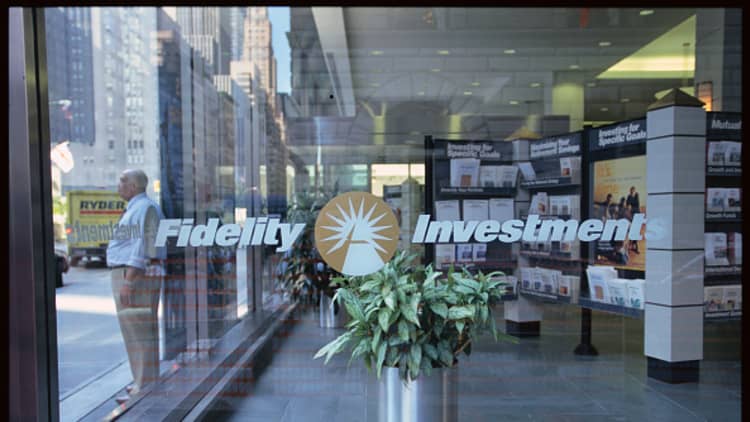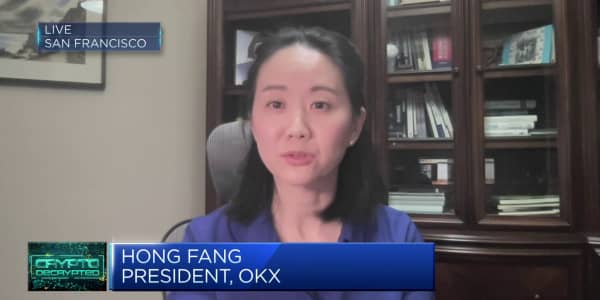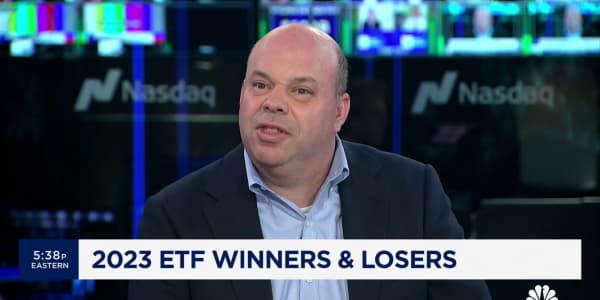J.P. Morgan has had several successes this year in the exchange-traded funds market as it attempts to increase its competitive positioning in what is increasingly an investment business where lowest-cost index funds wins the majority of assets.
Will the Wall Street bank be the first to a zero-fee ETF? That was the speculation on Tuesday in a report from financial trade publication CityWire, which picked up on a filing that J.P. Morgan made on Dec. 7 for a core U.S. equity ETF. In the preliminary prospectus for the planned ETF, J.P. Morgan left the expense ratio blank, leading to the idea the blank could represent a zero.
There is no way to know for sure — J.P. Morgan isn't saying anything — and after the success of Fidelity Investments' no-fee index mutual funds, a zero-fee ETF might make sense for a financial services company late to the ETF game and trying to play catch-up with Vanguard Group and BlackRock's iShares. But it is not exactly a Point A to Point B based on a preliminary prospectus leaving the expense ratio field blank.
In fact, that is not all that uncommon for initial fund filings with the Securities and Exchange Commission. It also is not uncommon for J.P. Morgan, which in recent years has filed multiple ETF registration statements that in their preliminary form do not state the expense ratio, including one this past summer for a core bond ETF. The filings make clear that they are "incomplete."
"Many sponsors do not disclose expense ratios in filings," said Neena Mishra, director of ETF research at Zacks Investment Research.
With the fee war between major ETF providers both brutal, and seemingly endless, there is more reason than ever before not to disclose a planned expense ratio, even if the plan is to charge more than nothing. In this case, if J.P. Morgan were to disclose a three-basis-point expense ratio, some other ETF company could file tomorrow for a similar ETF at two basis points.
"That gives them more flexibility to decide the fees later, based on the market environment then. So it's quite possible that JPM's fund would charge something close to 0.04 percent [four basis points] and not zero," Mishra said.
More from ETF Spotlight:
3 blue-chip stock buybacks that went horribly wrong
Bogle: If you hold the stock market, you will grow with America
But one thing is clear: The four basis points that Mishra references might be the most the bank could charge. And its new core U.S. equity ETF could do one notable thing: It could set the fee bar even lower than it already has been taken by Vanguard and iShares.
The Vanguard S&P 500 ETF (VOO) charges four basis points, as does the Vanguard Total Stock Market ETF (VTI). The iShares Core S&P 500 ETF (IVV) also charges four basis points. But iShares goes even lower in its Core S&P Total Stock Market ETF (ITOT), with a fee of three basis points. Charles Schwab's five core U.S. equity ETFs charge no more than three or four basis points, also the case for its traditional index funds.
A Bloomberg analysis this week showed that 97 percent of the assets going into passively managed investment products this year went to funds that charged 20 basis points or less.

If J.P. Morgan wants to make a splash — much like Fidelity did with its no-fee traditional index mutual funds, which now have a little more than $2 billion in assets — it doesn't need to charge nothing, but it might need to charge as little as two basis points, and at most four basis points, or else it won't have much of an offer to bring into the market.
"In order to appeal to investors, JPM would have to price their product below the four basis points that IVV and VOO charge," said Mishra. "That would give them the justification to shift their own client assets from competitors' large-cap ETFs and also gather a lot of money from new clients. And we know that the cost of operating an ETF goes down significantly with rise in assets. So an ETF that could likely gather billions of dollars within weeks of its launch would have very low operating costs."
The Fidelity Zero Total Market Index Fund (FZROX) had $1.6 billion in assets as of the end of November; and its Fidelity Zero International Index Fund (FZILX) had roughly $500 million in assets at the end of November. J.P. Morgan's BetaBuilder ETFs covering Japan, Canada and Europe — all launched this year at expense ratios that competed directly with existing offerings from ETF rivals — each took in more than $1 billion:
- JP Morgan BetaBuilders Japan (BBJP): $3 billion
- JP Morgan BetaBuilders Canada (BBCA): $2.1 billion
- JP Morgan BetaBuilders Europe (BBEU): $1.7 billion
The Japan and Canada ETFs charge 0.19 percent versus 0.49 percent for the iShares MSCI Japan (EWJ) and iShares MSCI Canada (EWC). The BetaBuilders Europe ETF charges 0.09 percent, versus the 0.10 charged by the iShares Core MSCI Europe (IEUR).
The lion's share of investor assets are in core U.S. equity funds. The four ETFs mentioned above from Vanguard and iShares have over $350 billion in assets between them, with IVV the leader at over $150 billion alone. This does not even include the granddaddy of all ETFs, the SPDR S&P 500 (SPY) with $250 billion in assets, though at what now could be described as a "pricey" nine-basis-points expense ratio, not in the same ballpark as the Vanguard and iShares offerings (it also is typically more of a trader than long-term investor tool).
Why JP Morgan could or couldn't be the one — or The Zero
There are a few reasons J.P. Morgan wouldn't make this core U.S. equity ETF the one that wins the race to zero. For one, there is no urgent reason to go to zero. As Bloomberg data after the launch of the BetaBuilders ETF showed, much of the money in those successes came from a captive audience — the bank's existing clients. It only needs to match its rivals expense ratios, or go one basis point lower to make a compelling case to switch, rather than all the way to zero.
The filed core U.S. equity ETF also is not self-indexed, like the Fidelity no-fee mutual funds. It is using a Morningstar U.S. Target Market Exposure Index, which covers the majority of the U.S. large-cap and mid-cap stock universes. Using a third-party index requires paying a licensing fee, a cost that Fidelity avoided. There are other ways to make money in ETFs, such as lending out securities held by the portfolios (securities lending), which is a standard practice in the fund industry. Or the bank — or any other firm to bring out a zero-fee ETF — could simply play the loss leader game, and make money elsewhere. That is Fidelity's plan, to be sure, and both it and J.P. Morgan have the scale of business to make that model work.
"It is just a matter of time before we see a zero-fee ETF, too," Mishra said. "The first offering could come from any big player in the asset-management space. J.P. Morgan could well be the one, given how aggressive it has been in the ETF space this year with its BetaBuilders lineup of cheap, plain-vanilla ETFs. ... As Fidelity showed, it is definitely worth sacrificing some money on the product."
J.P. Morgan could well be the one, given how aggressive it has been in the ETF space this year with its BetaBuilders lineup of cheap, plain-vanilla ETFs.Neena Mishradirector of ETF research at Zacks Investment Research
BlackRock CEO Larry Fink has said in the past that it has no plans for a zero-fee ETF. Vanguard made the decision last summer to make trading of all ETFs on its platform free, rather than focusing on further expense-ratio reductions.
J.P. Morgan did not provide a comment by press time.
There have been some criticisms of the latest moves in the low-fee war as more free advertising for funds than substance, especially the Fidelity move. The truth is somewhere in between. Fee pressure on funds is a good thing for investors, but getting a fund for nothing is not a must.
Fees already are so low that investors have won the war, and with existing ETFs at three to four basis points, other factors apply to investing decisions, from a fund's trading costs and liquidity to the index methodology that underlies it. Additionally, investors need to consider the other charges for trading and brokerage account services that could apply to their investments.
So when the first zero-fee ETF arrives, it will make news for sure, and it will be worth taking a look at, but it won't necessarily make the best investment ever.
Research from Cerulli Associates, a global research and consulting firm, shows that 68 percent of fund issuers see little or no impact on firm margins as a result of fee compression, and those impacted are likely to report that the lower margins will be offset by a fund's use in broader asset allocation models or in conjunction with other products and services.
"Looking at fees alone paints an incomplete picture of ETF success. Increasingly, issuers are likely to have competitive angles for their ETF product lines beyond simple revenue generation," said Daniil Shapiro, associate director in Cerulli's product development practice.
A zero-fee fund also may not be the last shot in the fee war.
Since a firm can leverage its existing distribution channels to attract clients via a zero-cost product and then provide more expensive offerings, going below zero is a possibility. "There has been industry discussion about ETFs going to not only zero but also negative. It wouldn't be shocking for an issuer to provide a negative-cost ETF product as a differentiator and a way to build brand equity which would then help drive sales into other products (whether or not they're ETFs)," Shapiro said.





